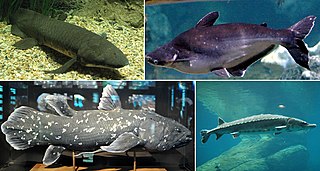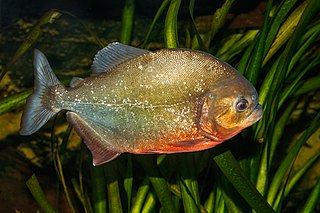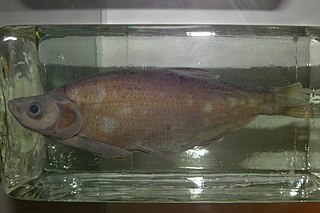
Osteichthyes, popularly referred to as the bony fish, is a diverse taxonomic group of fish that have skeletons primarily composed of bone tissue, as opposed to cartilage. The vast majority of fish are members of Osteichthyes, which is an extremely diverse and abundant group consisting of 45 orders, and over 435 families and 28,000 species. It is the largest class of vertebrates in existence today. The group Osteichthyes is divided into the ray-finned fish (Actinopterygii) and lobe-finned fish (Sarcopterygii). The oldest known fossils of bony fish are about 420 million years old, which are also transitional fossils, showing a tooth pattern that is in between the tooth rows of sharks and bony fishes.

Salmon is the common name for several species of ray-finned fish in the family Salmonidae. Other fish in the same family include trout, char, grayling, and whitefish. Salmon are native to tributaries of the North Atlantic and Pacific Ocean. Many species of salmon have been introduced into non-native environments such as the Great Lakes of North America and Patagonia in South America. Salmon are intensively farmed in many parts of the world.

Cod is the common name for the demersal fish genus Gadus, belonging to the family Gadidae. Cod is also used as part of the common name for a number of other fish species, and one species that belongs to genus Gadus is commonly not called cod.

A tuna is a saltwater fish that belongs to the tribe Thunnini, a subgrouping of the Scombridae (mackerel) family. The Thunnini comprise 15 species across five genera, the sizes of which vary greatly, ranging from the bullet tuna up to the Atlantic bluefin tuna. The Atlantic bluefin averages 2 m (6.6 ft), and is believed to live up to 50 years.

Mackerel is a common name applied to a number of different species of pelagic fish, mostly from the family Scombridae. They are found in both temperate and tropical seas, mostly living along the coast or offshore in the oceanic environment.

Pollock or pollack is the common name used for either of the two species of North Atlantic marine fish in the genus Pollachius. Pollachius pollachius is referred to as pollock in both North America and the United Kingdom, while Pollachius virens is usually known as coley in the British Isles. Other names for P. pollachius include the Atlantic pollock, European pollock, lieu jaune, and lythe; while P. virens is also known as Boston blue, silver bill, or saithe.

Herring are forage fish, mostly belonging to the family Clupeidae.

Tilapia is the common name for nearly a hundred species of cichlid fish from the coelotilapine, coptodonine, heterotilapine, oreochromine, pelmatolapiine and tilapiine tribes, with the economically most important species placed in Coptodonini and Oreochromini. Tilapia are mainly freshwater fish inhabiting shallow streams, ponds, rivers, and lakes, and less commonly found living in brackish water. Historically, they have been of major importance in artisanal fishing in Africa, and they are of increasing importance in aquaculture and aquaponics. Tilapia can become a problematic invasive species in new warm-water habitats such as Australia, whether deliberately or accidentally introduced, but generally not in temperate climates due to their inability to survive in cold water.

A piranha or piraña, a member of family Serrasalmidae, or a member of the subfamily Serrasalminae within the tetra family, Characidae in order Characiformes, is a freshwater fish that inhabits South American rivers, floodplains, lakes and reservoirs. Although often described as extremely predatory and mainly feeding on fish, their dietary habits vary extensively, and they will also take plant material, leading to their classification as omnivorous.

Sprat is the common name applied to a group of forage fish belonging to the genus Sprattus in the family Clupeidae. The term also is applied to a number of other small sprat-like forage fish. Like most forage fishes, sprats are highly active, small, oily fish. They travel in large schools with other fish and swim continuously throughout the day.

The term billfish refers to a group of predatory fish characterised by prominent bills, or rostra, and by their large size; some are longer than 4 m (13 ft). Billfish include sailfish and marlin, which make up the family Istiophoridae, and swordfish, sole member of the family Xiphiidae. They are apex predators which feed on a wide variety of smaller fish, crustaceans, and cephalopods. These two families are sometimes classified as belonging to the order Istiophoriformes, a group with origins in the Late Cretaceous around 71 million years ago with the two families diverging from one and another in the Late Miocene around 15 million years ago. However, they are also classified as being closely related to the mackerels and tuna within the suborder Scombroidei of the order Perciformes. However, the 5th edition of the Fishes of the World does recognise the Istiophoriformes as a valid order, albeit including the Sphyraenidae, the barracudas.

Fish are gill-bearing aquatic craniate animals that lack limbs with digits. They form a sister group to the tunicates, together forming the olfactores. Included in this definition are the living hagfish, lampreys, and cartilaginous and bony fish as well as various extinct related groups.

Culter is a genus of cyprinid fish, consisting of four species found in freshwater of eastern Asia. The name is derived from the Latin word culter, meaning "knife". Culter is closely related to Chanodichthys and some species have been moved between these genera.

An endangered species is a species that is very likely to become extinct in the near future, either worldwide or in a particular political jurisdiction. Endangered species may be at risk due to factors such as habitat loss, poaching and invasive species. The International Union for Conservation of Nature (IUCN) Red List lists the global conservation status of many species, and various other agencies assess the status of species within particular areas. Many nations have laws that protect conservation-reliant species which, for example, forbid hunting, restrict land development, or create protected areas. Some endangered species are the target of extensive conservation efforts such as captive breeding and habitat restoration.

An anchovy is a small, common forage fish of the family Engraulidae. Most species are found in marine waters, but several will enter brackish water, and some in South America are restricted to fresh water.

Fish are very diverse animals and can be categorised in many ways. This article is an overview of some of ways in which fish are categorised. Although most fish species have probably been discovered and described, about 250 new ones are still discovered every year. According to FishBase, 34,300 species of fish had been described as of September 2020. That is more than the combined total of all other vertebrate species: mammals, amphibians, reptiles and birds.
Culter flavipinnis is a species of cyprinid fish that is endemic to Vietnam.

The predatory carp, also known as the redfin culter, is a species of ray-finned fish in the genus Chanodichthys. This East Asian freshwater cyprinid ranges from the Amur River south to Taiwan and the Red River, as well as Lake Buir in Mongolia. It reaches 102 cm in length and 9 kg (20 lb) in weight.

Culter alburnus is a species of ray-finned fish in the genus Culter.
Culter oxycephaloides is a species of ray-finned fish in the genus Culter.

















